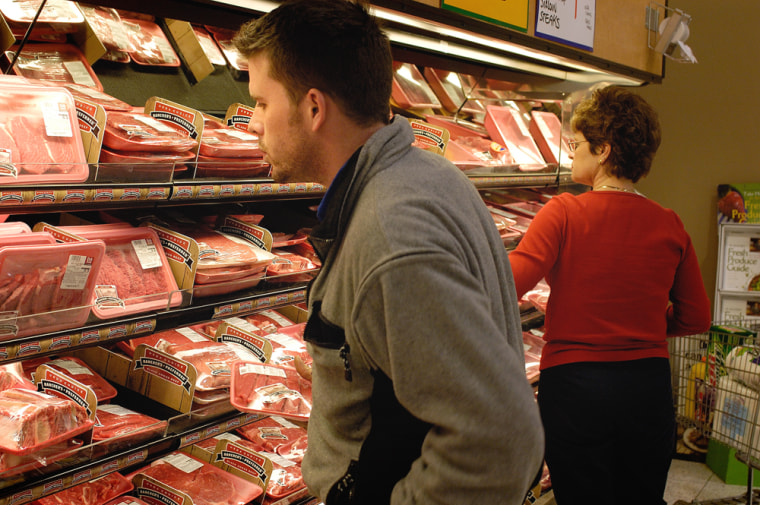This week, Herb tackles how food is labeled in grocery stores. Exactly how useful are the labels? Are they even a service to consumers?
My question deals with the chicken I find at the supermarket. Some brands have labels on them boasting that they are “hormone-free.” I thought all farmers were prohibited from giving their chickens hormones. Is that true? If so, this seems like a sneaky way for these companies to make their product appear superior to others when it’s not. It seems like someone needs to cry “fowl play” on this!
— Terry B., Woodinville, Wash.
You are absolutely right. USDA regulations prohibit poultry growers from giving hormones and steroids to their birds, so all chicken is hormone-free. This label, while truthful, is also potentially misleading. It’s like putting a “cholesterol-free” sticker on a banana — sounds good until you realize that all bananas are cholesterol-free.
“Don’t be fooled by this,” warns Urvashi Rangan, a senior scientist at Consumer Reports. This chicken “isn’t worth any more money than a poultry product that does not make this claim,” she says.
And get this: While hormones are prohibited, growers can still give their hormone-free chicken “antibiotics every single day,” Rangan says. These drugs, commonly used by farmers, serve the same purpose as hormones — to increase the growth rate.
A marketplace of misleading labels
This is just one example of how misleading labels are used to grab a shopper’s attention and move product. “It’s amazing what’s out there,” says Ilene Ringel Heller, a senior attorney with the Center for Science in the Public Interest. She believes this deception is deliberate, because it appeals to consumers “who want to buy something that’s good for them.”
For instance, "secret shoppers" for the consumer group are finding a variety of “whole wheat” products with very little whole wheat. If you want the benefits of whole wheat, look for a label that says “100 percent whole wheat.”
Juice drinks can be especially misleading. The product may not be all juice, and it may not be the juice you’d assume it to be. For example, Tropicana's Peach Papaya drink does not contain any peach or papaya juice. It’s mostly water, sweeteners and some pear juice. Last August parent company PepsiCo settled a lawsuit by agreeing to call the product “Peach Papaya flavored juice drink.” It has also removed the claim “made with REAL fruit juice.” And yet the package still has pictures of peaches and papayas on it.
Remember, if a juice product is called a “beverage,” “drink” or “punch,” you can bet it is not 100 percent juice. It probably contains a large amount of water, sweeteners and white grape juice, which is cheap and not very nutritious. The only way to know for sure is to check the ingredient label.
‘Basically a crock’
The next time you’re at the supermarket notice how many companies put “natural” on the packages. But in most cases, CSPI’s Heller says, the natural label “is basically a crock” because the Food and Drug Administration does not have an official definition for the term. They’ve been working on it, Heller says, since the mid-1970s. In the absence of government regulation, each manufacturer decides if its product is natural or not. “Arsenic is natural, too,” she notes sarcastically.
This past week, CSPI threatened to sue Cadbury Schweppes over the company’s new “100 percent natural” advertising campaign for 7-UP. Like many other soft drinks 7-UP contains high fructose corn syrup — a cheap substitute for sugar that consumer groups consider to be an artificial ingredient. The company says high fructose corn syrup is indeed natural.
CSPI executive director Michael Jacobson says high fructose corn syrup “isn’t something you cook up from a bushel of corn in your kitchen, unless you happen to be equipped with centrifuges, hydroclones, ion-exchange columns and buckets of enzyme.”
Consumer Reports’ Rangan says manufacturers “can get away with putting a lot of artificial ingredients in food and still calling it natural.” Besides high fructose corn syrup, she points to partially hydrogenated oil. “It requires chemistry to make partially hydrogenated oil,” she says, which is why the magazine considers them to be “artificial or synthetic substances.”
The process that produces hydrogenated oil also creates trans fat, which is the worst kind of fat you can eat. Many manufacturers now boast that their products have no trans fats — and that’s good — but “trans fat free” does not mean fat free. There’s a good chance the trans fat has been replaced with saturated fat, which health experts say is almost as bad for you.
Natural meat & poultry
The USDA does define what natural means when it’s used to describe meat or poultry products, but according to Rangan that definition is “very, very loose and vague.”
The USDA says if a food containing meat or poultry is called natural, it cannot contain any artificial colors or additives. It has nothing to do with what the animal ate or how it was raised. Natural does not mean “organic,” and it does not mean “antibiotic-free.”
Organic
Organic is one term you can generally trust because it’s defined by federal regulation. But don’t be fooled by an “organic” label on a seafood product. The USDA has not decided what organic means when applied to seafood, so the claim is meaningless.
Be a smart label reader
Don’t expect the federal government to put much effort into cracking down on misleading or deceptive food labels. Food inspectors have focused their limited resources on safety and bio-terrorism.
That means you, the shopper, need to look past the big bold claims on the front of the package. Check for the fine print that modifies that claim. Most importantly, read the nutrition label to get the true picture of what’s in that product. Remember, ingredients are listed from highest amount to lowest amount.
In the words of CSPI’s Heller, the marketplace right now is “caveat emptor (let the buyer beware) more than ever.”
